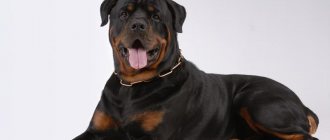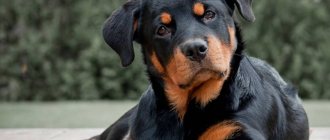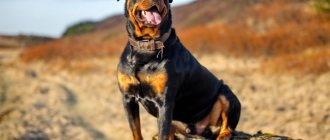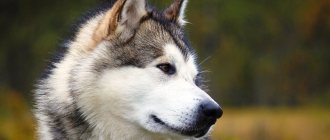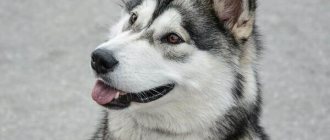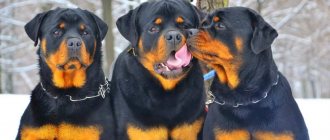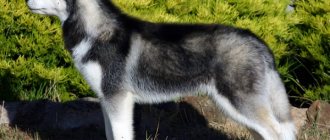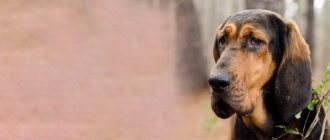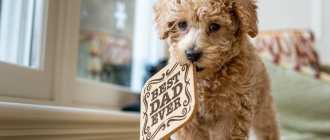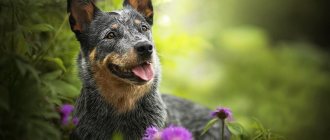Short description
The Rottweiler is a short-haired dog of medium to large height that belongs to the Molosser group.
These are smart and quick-witted animals, distinguished by their powerful build and strong character..
Strong bones, well-developed muscles and proportional build make Rottweilers strong, hardy and at the same time agile.
Loyal to their owners and distrustful of strangers, these dogs are equally excellent both in guard service and as bodyguards.
At home, Rottweilers are calm and friendly towards their owner and his family members..
The Rottweiler is a breed that is strongly focused on its owner, whom he, as a rule, chooses for himself. The dog treats all other family members neutrally or patronizingly.
Origin story
The ancestors of Rottweilers were herding dogs of the Molossoid type, which appeared in ancient times..
They were also widely used as hunting and guard dogs, thanks to which the suitability for a wide variety of work was established in the breed at the genetic level, which later, already in the 20th century, made it possible to further expand the scope of Rottweilers: they began to be used in police work, as rescue dogs, as well as for guard duty.
In the Middle Ages, the main task of Rottweilers was herding livestock, driving them to another pasture and protecting them from predators . These dogs were also used on farms in Germany to transport goods and as bodyguards and fighters.
In those days, when breeding dogs, people paid attention only to their working qualities, which is why they often practiced crossing Rottweilers with other Molossians.
Before the adoption of the modern standard, the dog population was distinguished by a wide variety of colors and was unequal in size and type of build.
Character traits
Calm, brave and confident dogs, distinguished by discipline and obedience.
The Rottweiler is reserved and reasonable.
Thanks to their innate protective instinct, representatives of this breed are considered one of the best guard dogs. At the same time, a properly raised Rottweiler does not show unreasonable aggression towards strangers.
He may well live peacefully in the same house with other animals, but it is necessary to introduce him to other pets at an early age.
Properly raised Rottweilers also treat children well: they look after them and, if necessary, are always ready to protect them.
Expert opinion
Kozhevin Semyon Kirillovich
Expert dog handler.
“The character of the Rottweiler cannot be called simple. This is a dog that is aware of its power, and also has a well-developed sense of self-esteem. Not everyone can become a real master for a Rottweiler, whom he will obey unquestioningly. Only a physically strong person, who, moreover, can actually prove his superiority, will become an authority for such a dog. A Rottweiler is not just a dog, it is a person who must be treated with respect, but at the same time, the dog must feel that the owner is stronger than him not only physically, but also morally.”
Character and intelligence
The dog has a strong and independent character. The animal is characterized by a high level of intelligence; it enjoys participating in outdoor games and sports training. The dog has a pronounced guard instinct, so he makes an excellent guard.
During the attack, the animal shows courage and bravery. The Rottweiler is devoted to its owner and is ready to protect him even at the cost of his own life. The dog gets along well with children and pets.
Some Rottweilers may experience deviations in the emotional and volitional sphere. These include:
- Cowardice and uncertainty.
- Excessive aggression.
- Hyperexcitability.
Pros and cons of the breed
pros
- Loyal to its owner.
- Very smart and quick-witted.
- It is distinguished by great physical strength and endurance.
- Representatives of this breed are among the best guard dogs in the world.
- He does not require complex care.
- This dog is suitable for both rural areas and the city.
- If raised correctly, the Rottweiler can become a very good companion for children.
- With timely socialization, it gets along peacefully with other animals.
Flaws
- Needs professional training.
- The owner of such a dog can only be a physically strong person.
- Rottweilers learn somewhat more slowly than most other dogs.
- Not suitable for keeping in small apartments.
- Due to rapid growth and weight gain, health problems may begin during puppyhood.
If raised incorrectly, the Rottweiler can take the place of the “leader of the pack” in the family, which is fraught with the most serious consequences..
Breed standard
The Rottweiler's exterior speaks of agility, power and endurance. This is a fairly large breed, neither light nor heavy in appearance. The weight of adults is 45-50 kg . with a height of 55-70 cm . Bitches are inferior to males in both height and weight.
A large, slightly elongated head rests on a short, thick neck without dewlap. The ears are triangular in shape and drooping. Dark almond-shaped eyes, an attentive, wary gaze. The nose is wide, black with large nostrils. The jaws are powerful with a scissor bite.
The physique is compact and proportional. The back is straight, the croup is of medium length and wide. The limbs are muscular, smooth, parallel. The tail is natural, docking is allowed.
The short coat has an undercoat, the outer coat is thick, hard, and coarse. The coat color is black with red-brown tan. According to the standard, a single white spot on the chest is allowed.
Main types
Currently, the most popular varieties of Rottweilers are:
- Germanic . This type of breed is considered classic and it is this type that is taken as the standard of this breed. Based on the parameters of these dogs, described by the All-German Rottweiler Club, the International Canine Federation developed a breed standard.
- English . British Rottweilers are very similar in appearance to their German relatives. But at the same time, as befits true Englishmen, they are calm and even phlegmatic. Only if urgent protection of the owner or someone close to him is necessary, English-type Rottweilers can attack without a command.
- American . American Rottweilers are very large and powerful dogs. When breeding them, breeders deliberately selected the tallest and most vicious representatives of the breed, as they wanted to breed guard dogs that were characterized by increased aggression towards strangers. And in order to keep their increased aggression under control, such animals need very serious professional training.
Info: from time to time Rottweilers are born whose height is much less than the lower limits of the standard . These dogs are called mini Rottweilers.
Color variations
The only acceptable standard color for a Rottweiler is black and tan..
But, besides him, from time to time dogs with non-standard colors are born, such as pure black, gray, brindle, reddish fawn, golden, white.
Also, Rottweilers may have white markings of varying sizes, located on a main, darker background.
CAREFULLY!
Any other colors other than black and tan are considered a defect in the breed: such dogs are not allowed for exhibitions or for breeding.
Dear friends! I promised to share with you some materials from my interview with the Kennel Club of India magazine. I deliberately omit the translation of some of the questions to which I have already given answers earlier. There are also general questions, the answers to which are well known to everyone. However, I left a few general questions, the answers to which will be of interest to many:
Manjunath M.R: Tell us what made you become seriously interested in Rottweilers? What do you like about Rottweilers? How did it all begin?
Tatyana Burdina: My parents loved dogs very much, and dogs always lived in our house. At the age of 13, I became seriously interested in dog breeding and really wanted my own dog to participate in dog shows. In those years, I didn’t care what breed the dog was. The main thing is that I wanted it to be a big dog that I could train and participate in shows with. My parents and I went to exhibitions for a long time and finally chose a breed. Our choice fell on the Rottweiler, which in those years was a very rare breed. On my 14th birthday I received my first Rottweiler as a gift. His name was Korda. She lived next to me for 11 years. My love and devotion to this breed began with this dog. I fell in love with Rottweilers for their independent, loyal and strong character. I like that the Rottweiler is not picky or intrusive. This breed endlessly loves its owner and is ready to serve only him.
Manjunath M.R.: We all grow and change as we learn more as breeders. When you first started your program, what was your goal?
Tatyana Burdina: When I got my first dog, I was still a teenager. In those years, I could not create my own nursery, and I did not have a breeding program. In those years I studied a lot. I became an active member of the Service Dog Club. I wanted to help club members have the most beautiful Rottweilers that meet the highest international standards. I went to exhibitions in different cities, wrote letters to other clubs, studied the experience of working with the breed, found out where there were beautiful dogs of our breed, and tried to bring the best puppies to my city. I spent a lot of time with my first dog in the training area. I became a training instructor, led groups on OKD and ZKS, taught at the School of Young Dog Breeders at the House of Pioneers. Later I became a conformation and performance judge. In 1990, I, with a small group of enthusiasts, went to the World Dog Show (Brno). This was the first opportunity to come and see dogs abroad. I was lucky because at this exhibition I saw in life the great German sires, legendary dogs of the past: Benno v Schwarzen Haide, the great-grandson of the famous Ives vom Eulenspigel, who became the World Champion, and the 10-month-old Doc vd Toufelsbrucke. I saw a completely different Rottweiler and realized what a real and beautiful Rottweiler is. I have always had a dream to have such a strong, dry and handsome winner. I am very glad that my dreams came true.
Manjunath M.R.: In general, people think that Rottweilers are dedicated, obedient, and willing to work. What is your opinion?
Tatyana Burdina: Over the 30 years that I lived next to a Rottweiler, I became convinced that there is no more intelligent, loyal and obedient dog in the world. It is important that you have enough time to work with, walk, play and train your beloved dog. If you devote enough time to raising your dog, you will have the most loyal and very smart friend in him.
Manjunath M.R.: Which dog do you consider to be the basis of your breeding program?
Tatyana Burdina: The founder of my nursery was Polnigres Hart - 10/5/1989. Polya (her home name). (I wrote about this earlier in my articles for Russian readers)
Manjunath M.R.: What do you consider the ideal Rottweiler?
Tatyana Burdina: What is the ideal Rottweiler? This is a large, very strong, fairly agile dog with a large dry head, wide cheekbones, small, well-set ears, dark open and lively eyes. He should have a broad chest, a strong body and good angulation of the limbs. The Rottweiler should be cheerful, open, and not cowardly or aggressive.
Manjunath MR: What do you consider to be your greatest achievement in your Rottweiler breeding career?
Tatyana Burdina: I consider the greatest achievement in Rottweiler breeding to be the birth of real German Rottweilers in our kennel, both in appearance and in character. Many famous dogs were born in our kennel, but I would like to mention the most famous on the world stage: my favorite dog is Olburd Gots-1999. This dog made a name for us. Years later, Rottweiler owners remember and know this dog. Years have passed, but I still remember that day at ADRK 2000 when he demonstrated his running in the junior class and the whole stadium clapped for him. I had goosebumps running down my spine, and then there were people I knew and didn’t know very well who came up and congratulated me... He was a fantastically efficient dog, had a very beautiful, strong body, like a real Rottweiler. 2 years in a row he became second in class according to ADRK (2000 and 2001) only because he had a docked tail, and all his German competitors already had tails... His finest hour was when he became the young winner of the International Rottweiler Club Rottweiler ( IFR) 2000 in Belgium. His success was repeated by Olburd Sulivan, who also became the Junior Winner of the International Rottweiler Club in 2016, and then the World Champion in 2022. I'm proud of these great dogs!
Manjunath M.R.: What are you currently focusing on in your breeding program? How has your goal changed, and if it has changed, why?
Tatyana Burdina: My priority in breeding remains the task of getting a real German Rottweiler. He must be strong and powerful, dry, have a beautiful expressive head and excellent character. Today it is very important for me to have dogs with beautiful, correct bodies. Unfortunately, there are very few of them now. Today we have to confront those who, in pursuit of fashion and quick sales, are trying to breed very raw dogs. Such dogs are similar to mastiffs or Bordeaux dogs and are completely unable to perform the functions of a real Rottweiler.
Manjunath M.R.: Every judge prefers something different while judging. What do you focus on when you judge?
Tatyana Burdina: It is very important for me that the dog is harmonious. First of all, the right type is important. The Rottweiler should not look like any other breed. There should be no deviations either towards lightness or excessive dampness. It is very important to me that the dog has the correct anatomy and character.
Manjunath MR: What are your 3 favorite Rottweilers from the past that you have encountered and also your 3 favorite Rottweilers from your kennel?
Tatyana Burdin: If we talk about foreign favorites, then, probably, from the past I liked Benno v Schwarzen Haide most of all - who changed my idea of the breed, then, of course, Filou vom Rauberweg - a stunning trotter, a dog with very beautiful movements that flew across ring like a rocket and the incomparable Imperator vom Hause Zshammer is a dog that everyone would like to have.
Among the dogs in my kennel are Olburd Gots, Olburd Sulivan, and among the females Olburd Only.
Manjunath M.R.: Do you choose line breeding or type for type? What do you prefer?
Tatyana Burdina: As a biologist by training, I believe that only linear breeding can create truly beautiful and stable dogs. But of course you can't just look at the pedigree and not consider the type of dogs being crossed. In order to get a good result, it is important to imagine what your dog’s ancestors looked like and whether they were similar to those you are inbreeding with. It is important to understand why you need this or that inbreeding, what do you want to get in the end?
Manjunath M.R.: From your observations, how has the Rottweiler breed changed over the years of breeding in terms of health, temperament and structure?
Tatyana Burdina: In general, some things have changed for the better, but some have not. Over the years, the Rottweiler's head has changed a lot. In general, the dogs' heads have become more beautiful and expressive. Dogs with hound-like heads have almost disappeared. However, many breeders focused on the dog’s head and completely stopped paying attention to the structure of the body. Today there are practically no dogs that have a beautiful head and a good body. There are a lot of dogs with a narrow chest, straight shoulders, curved forearms, a short chest bone, and a soft back. Excessively hypertrophied dogs appeared with hypertrophied folded heads and round bulging eyes. Very little attention has been paid to the character and training of the Rottweiler, in some countries they have become a large plush toy.
Manjunath M.R.: I understand that Rottweilers are one of the popular breeds in Russia. How many participants can be expected at a national specialized exhibition?
Tatyana Burdina: Unfortunately, the Rottweiler is not the most popular breed in Russia. The largest specialized exhibitions today attract about 130 dogs. However, I want to say that most of these dogs are perfectly prepared and trained. There are no random contestants on these shows. Most of the participants are professional breeders with their best dogs.
Manjunath M.R.: Which breeders in Russia, in your opinion, make a significant contribution to the development of the breed?
Tatyana Burdina: Russia is a huge country, and we have excellent breeders. The Rottweiler breed club of Russia annually conducts a rating of breeders taking into account the quality of the dogs, their victories at exhibitions, and the passing of the kerung. Last year, 55 nurseries took part in the overall ranking. Five leaders: Olburd, from the House of Torra, Berega Tura, Rotfart, Tverskoy House.
Manjunath M.R.: As an active Rottweiler breeder, how would you define a “good breeder”?
Tatyana Burdina: In my opinion, a good breeder is one who does not hide his successes and failures from colleagues, is ready to share his experience, and who cares about the quality of the breed as a whole. He does not follow fashion for the sake of a quick and profitable sale. A real breeder remembers that the breed is in his hands temporarily. Only his intelligence and talent will allow him to leave his mark and his name on the great dogs.
Manjunath MR: What steps can breeders take to prevent the breed from splitting from working Rottweiler to show Rottweiler?
Tatyana Burdina: It is very important that all individuals of the breed are not only beautiful, but also maintain a good temperament and are suitable for training and work. There are many large ornamental breeds, but most of them are completely unsuitable for any service. A Rottweiler should not be allowed to be turned into a teddy bear that is only good for photography. I think it is very important to check the character and behavior of dogs. Many countries, including Russia, do not allow breeding of animals without working diplomas. In addition, all working class dogs must be tested on the day of the show. The title of National Club Champion cannot be obtained by a dog without passing Kerung. Starting this year, the rules for the International Rottweiler Championship (IFR) have changed. All dogs over 15 months of age will not be eligible to win unless they are BH certified and have passed a behavior test prior to the show.
Manjunath M.R.: The trend we are seeing in the breed is strong hocks and loose ligaments in the hindquarters. Does the trend toward more extreme lean angles play a role in this problem we're seeing now?
Tatyana Burdina: Individuals with very long hind limbs look very beautiful in an expressive stance, especially when the handler stands behind and pulls the dog towards himself, resting its hind limbs on his legs. But this beauty is deceptive. Once you loosen the leash, all this imaginary harmony is disrupted. I completely agree with many breed judges who prohibit this manner of demonstrating a dog. In addition, there is a tendency to show the Rottweiler at a very fast pace. This is fundamentally wrong! The Rottweiler is young and we are not racing for a mechanical hare! An attempt to hide anatomical problems at a fast pace is obvious! We see how many problems a German Shepherd has with excessively angulated limbs. For such a heavy Molosser as the Rottweiler, this is completely wrong. Excessively pronounced angles of the limbs lead to weakness of the ligaments and a very large load on them. Today, a very large percentage of dogs have problems with torn knee ligaments. This is the other side of this coin... The Rottweiler should have moderate angulation in the hindquarters and strong ligaments in both the front and hindquarters. It seems to me that we need to pay close attention to this.
Manjunath M.R.: Is excessive angulation becoming a problem for the breed? Could you briefly discuss the bending associated with the dog's movements?
Tatyana Burdina: As I said earlier, we often see a complex of problems in the structure of the hind limbs. Typically, dogs have an excessively sloping croup, short and narrow hips, and very long shins. Such dogs cannot stand correctly in a natural stance. Usually they put their legs under the body, and we see a dog with a crooked topline. It is very important to ensure that the angles of the front and rear legs are proportional. A lot of dogs have short forearms and dogs in general are short-legged. The length of the thigh and thigh should be almost equal to each other. The hip should be wide and the angle at the knees should be clearly defined. It is with such a structure that productive movements will be ensured. A properly built dog stands naturally and will be able to move for a long time without much effort.
Manjunath M.R.: How do you select the right partner to breed your bitch?
Tatyana Burdina: The choice of a partner is influenced by many factors: Of course, it should be a beautiful dog that we like by type and belongs to the line with which we are working. He should not have common shortcomings with our bitch. Over the years of working with the breed, we have developed our own type of dog, and we do not want to add animals of completely different lines to our dogs. Usually we consider all famous producers, but we never choose a partner based on a photo, but always look at him in real life at an exhibition or specially visit the nursery where he lives, even if it is another country. It is important for us that the partner comes from a hereditarily successful litter, has beautiful brothers and sisters, and it is desirable that he already has beautiful descendants. We carefully look at the dog’s character, see how he behaves in life. Tests for hereditary diseases are required.
Manjunath M.R.: What areas do you think Rottweiler owners should focus on in more detail and why?
Tatyana Burdina: In my opinion, today we need to pay more attention to the correct body structure and consider the dog in a free stance. If the dog is built correctly, it will stand beautifully. Proper body structure is the key to a dog’s health and longevity. It is important to maintain the correct head of the Rottweiler and stop breeding overly hypertrophied, overly snub-nosed dogs with many wrinkles on the head. It is worth paying attention to the correct placement of the ears, then the Rottweiler’s head will be as expressive as possible.
Manjunath MR: What do you like to see in a Rottweiler that enters your ring?
Tatyana Burdina: Confident behavior and good physical fitness
Manjunath MR: What should we as owners, breeders, handlers and lovers of this breed do to steer the development of the breed in the right direction? Tatyana Burdina: Love your dogs and give them as much attention as possible. Manjunath M.R.: Do you see different handling in different countries in the way handlers present dogs to you? What do you like to see from the handlers who show dogs in your ring?
Tatyana Burdina: It seems to me that the handler should show the dog as naturally as possible, there is no need to run very fast, there is no need to hang or lift the dog too much. Nowadays it has become very fashionable to show the Rottweiler at a very fast trot, which is completely uncharacteristic of the molos breed to which the Rottweiler belongs. It is important that the dog moves naturally and does not wheeze or become overexcited. It seems to me that any style of work by handlers is acceptable, the main thing is that the handler does not interfere with the judge’s correct assessment of the dog.
Manjunath M.R.: What behavioral characteristic is most typical of the breed?
Tatyana Burdina: Confident behavior
Manjunath M.R.: Could the current emphasis on drive be problematic? Tatyana Burdina: Yes, maybe dogs become overly nervous and excitable. There must be moderation in everything. Overly excitable dogs are less trainable and it becomes difficult to keep them in a regular home outside of kennels.
Manjunath M.R.: When two dogs are comparable, what determines which dog will stand in front of the other and what are you looking for?
Tatyana Burdina: For me, the general expression and expression is very important, so that the dog has the right look, the shape of the eyes, the ears fit tightly, I try to see the overall harmony. Good growth and strong bones, no wrinkles on the head, are important to me. All things being equal, I will always choose a larger and stronger dog.
How to feed
The Rottweiler needs proper and nutritious nutrition. These dogs can be fed both professional ready-made food and home-cooked food.
If the dog eats ready-made food, the choice should be made in favor of premium food and higher, suitable for large breeds of dogs.
If the pet eats natural food, then the basis of the diet should be fermented milk products in puppyhood and meat or offal for adult animals.
Food must be fresh and good quality. You should not feed your dog either too cold or too hot natural food: it should be well warm.
Health and major diseases, life expectancy
Rottweilers are strong and resilient animals.
However, they are predisposed to a number of diseases, including the following ailments:
- Dysplasia.
- Osteochondrosis.
- Retinal atrophy.
- Cataract.
- Turning of the eyelids.
- Obesity.
- Diabetes.
In addition, these dogs do not tolerate extreme heat well and can easily overheat or get sunstroke.
The average lifespan of Rottweilers is 10-12 years .
Proper care and good living conditions can prolong the life of a Rottweiler.
Rottweiler diseases
Adult dogs suffer from the following diseases:
- Joint dysplasia.
- Osteochondrosis.
- Diabetes.
- Flatulence, bloating.
- Cardiovascular pathologies.
- Cancer.
Rottweiler puppies may be susceptible to the following ailments:
- Leptospirosis.
- Plague.
- Coccidiosis.
- Hepatitis.
Various intestinal infections pose a particular danger to the Rottweiler's health. High-quality vaccines and proper nutrition can prevent their occurrence. Once every six months, the dog must undergo a preventive examination at a veterinary clinic.
Raising a dog
You need to start training a Rottweiler as early as possible, since it is very important from the first day to let the puppy understand that he is not the boss in the house, but his owners.
IMPORTANT!
The first commands that should be taught to your pet should be “Place”, “No!”, “Ugh!”, “Come to me!”.
Around this time, the puppy is taught his name, as well as a diaper or litter box.
Subsequently, when the Rottweiler grows up, his training should be entrusted to a professional trainer.
You should not set your Rottweiler against other animals or people, as this can lead to the dog becoming aggressive and uncontrollable..
Training and education
The Rottweiler is prone to dominance; at the slightest opportunity, the dog strives to dominate not only over its own kind, but also over its owner. Therefore, it is difficult for an inexperienced dog breeder to cope with the difficult character of a pet without the help of a dog handler.
Be sure to read our articles:
The dog doesn’t listen or “Who’s the boss?!”
Raising a puppy. Where to start and how to succeed
Under no circumstances should you indulge your dog. Education and training must be carried out firmly, but physical punishment and aggression on the part of the owner are unacceptable. The dog must trust the owner, respect him, but not be afraid or angry. If the above conditions are met, the Rottweiler will quickly learn all the lessons and will obey all commands without question.
During the training process, you need to take into account the fact that the Rottweiler is very smart and at the same time very cunning. If the owner gives a slack, the dog will immediately react to it with further disobedience. It often happens that the Rottweiler refuses to carry out an already learned command, showing with all his appearance that he does not understand what is required of him. This is explained by cunning and deception; the dog simply does not want to work. Having conceded once in such a situation, the owner will concede constantly. In any case, having given a command, it is necessary to ensure its execution.
Interesting Facts
- In Rottweil, butcher shop owners trusted their dogs so much that they entrusted them with the delivery of money. A bag with proceeds was tied to the Rottweiler's collar and sent home. No robber would dare attack such a courier, so the money was delivered safe and sound to the specified location.
- There are cases where a Rottweiler lived for 17 years or more.
- The Rottweiler is capable of transforming at lightning speed. For example, when playing with a child, he frolics like a carefree puppy, but noticing the danger, the dog instantly turns into an aggressive beast with bloodshot eyes and a bared mouth.
- Interestingly, the fearsome Rottweiler’s favorite treat is cheese.
Features of care
The dog's coat should be brushed 2 or 3 times a week, and once a day when shedding. A dog of this breed does not need frequent washing: it is enough to wash it 2 times a year.
You should trim your pet’s claws, as well as clean his eyes, ears and teeth as needed..
In accordance with the schedule, the dog must be vaccinated and dewormed in a timely manner.
To prevent the appearance of external parasites, it is recommended to regularly treat your Rottweiler with flea preventatives..
As for keeping dogs of this breed, it is better to keep them in a country house in a special enclosure.
Also read about who is better to choose for keeping in an apartment - a Rottweiler or a Doberman.
Certificates and titles
In the ring, at the discretion of the expert, certificates may be issued and the following titles may be awarded:
- CW – class winner, awarded to the first dog in the class to receive the highest score. The winner of the class receives the title of JKCHK or CCC at single-breed exhibitions of the rank of CHK, PC, and at the CCC he competes for the assignment of CCC.
- SS certificate of conformity.
- USS certificate of conformity in the junior class.
- Yu.KChK-candidate for young champions of the National Club.
- Candidate for National Club Champion.
- Yu.PK is the young winner of the National Club Club.
- PC-winner of the National Club.
- J.ChK - junior champion of the National Club.
- CHK-champion of the NKP.
On the page you can familiarize yourself with the preliminary schedule of single-breed exhibitions for 2022. Official source – https://rkf.org.ru/predvaritelnye-grafiki-monoporodnyh-vystavok-na-2022-god/.
Breeding
Breeding Rottweilers is not the easiest thing to do. And it’s not just that raising a litter, which can include nine or more puppies, is expensive, both morally and financially.
Difficulties begin already at the stage of selecting a partner: he must not only be good in appearance, but also have a balanced temperament and a character typical of the breed.
In addition, the dog must be completely healthy and come from lines free of dysplasia and other hereditary diseases.
Usually, dogs occur 11-14 days after the start of estrus.
Mating is carried out in the territory that the male considers his own: there he will feel more confident . In this case, both dogs must wear collars, and the bitch must also have a muzzle.
If the dog is vicious, then he also needs a muzzle.
If everything went as it should and the mating was successful, then approximately a two-month waiting period for the puppies begins, which ends with the birth of 3 to 12 babies.
Rottweiler puppies are relatively small in size, and therefore females of this breed give birth on their own and quite easily .
A female dog can be bred no earlier than she is one year and eight months old, and a male dog no earlier than one and a half years old.
Akita: special breed exhibitions for 2022
| Club | City | start date | expiration date | RANK |
| BGOO KK SIMURAN | Biysk | 19.06.2022 | 19.06.2022 | KCHK |
| Youth "AMIGO" | Bulatnikovskoe | 17.04.2022 | 17.04.2022 | KCHK |
| ROO FSS | Volgograd | 01.10.2022 | 01.10.2022 | NOT A MEMBER OF THE NKP |
| VROO KSODP “PHOENIX” | Voronezh | 28.05.2022 | 28.05.2022 | CCC in each class |
| VROO KSODP “PHOENIX” | Voronezh | 27.05.2022 | 27.05.2022 | CCC in each class |
| CCRT | Kazan | 25.12.2022 | 25.12.2022 | NOT A MEMBER OF THE NKP |
| CCRT | Kazan | 13.02.2022 | 13.02.2022 | NOT A MEMBER OF THE NKP |
| ROO “KLPZh RT” | Kazan | 15.05.2022 | 15.05.2022 | NOT A MEMBER OF THE NKP |
| ROO FSS RT | Kazan | 30.07.2022 | 30.07.2022 | KCHK |
| TRBOO “KFRT” | Kazan | 25.09.2022 | 25.09.2022 | KCHK |
| TRBOO “KFRT” | Kazan | 26.06.2022 | 26.06.2022 | REFUSAL AT THE NKP'S PETTION |
| CROO “KK “LUPUS” | Kerch | 16.04.2022 | 16.04.2022 | REFUSAL AT THE NKP'S PETTION |
| ROO CC TRIUMPH | Kotlas | 30.07.2022 | 30.07.2022 | KCHK |
| NGO “KKKSPS” | Krasnodar | 17.09.2022 | 17.09.2022 | CCC in each class |
| ROO “PKKTS” | Kungur | 17.09.2022 | 17.09.2022 | KCHK |
| MCOO “REVIVAL BIS” | Moscow | 14.08.2022 | 14.08.2022 | CCC in each class |
| MCOO “REVIVAL BIS” | Moscow | 13.06.2022 | 13.06.2022 | KCHK |
| ROO “DOG LOVERS CLUB “TREASURE ISLAND” | Moscow | 30.12.2022 | 30.12.2022 | REFUSAL AT THE NKP'S PETTION |
| NGO SCC “ERIDAN” NAKHODKA | Nakhodka | 17.09.2022 | 17.09.2022 | CCC in each class |
| NOOOLZH “FAUNA” | Nizhny Novgorod | 05.06.2022 | 05.06.2022 | CCC in each class |
| PROO “PENZA KENNEL” | Penza | 21.08.2022 | 21.08.2022 | NOT A MEMBER OF THE NKP |
| RROO “DKPTs” | Rostov-on-Don | 27.03.2022 | 27.03.2022 | NOT A MEMBER OF THE NKP |
| NGO “SVZH “VICTORIA” RYAO | Rybinsk | 16.10.2022 | 16.10.2022 | KCHK |
| RROO “CLS “LEGION” | Ryazan | 13.08.2022 | 13.08.2022 | CCC in each class |
| LO ROO KLZH “ASKONA” | Saint Petersburg | 31.07.2022 | 31.07.2022 | CCC in each class |
| ROO “SPB GKSS” | Saint Petersburg | 09.12.2022 | 11.12.2022 | KCHK |
| SPb ROO “DOG LOVERS CLUB “DOGSITY” | Saint Petersburg | 18.06.2022 | 18.06.2022 | KCHK |
| SPBROO CLS “SPARS” | Saint Petersburg | 19.11.2022 | 20.11.2022 | KCHK |
| SROOLZH “POKROVSKAYA SLOBODA” | Saratov | 26.03.2022 | 26.03.2022 | NOT A MEMBER OF THE NKP |
| SROOLZH “POKROVSKAYA SLOBODA” | Saratov | 26.03.2022 | 26.03.2022 | NOT A MEMBER OF THE NKP |
| SROOLS “DOG BREEDING CLUB” | Saratov | 03.09.2022 | 03.09.2022 | CCC in each class |
| NGO CLZ “OSIRIS” | Serpukhov | 28.05.2022 | 28.05.2022 | NOT A MEMBER OF THE NKP |
| SROO “PARITET” | Smolensk | 16.10.2022 | 16.10.2022 | KCHK |
| CCOO CLPS “AMICO” (Friend) | Sochi | 28.05.2022 | 28.05.2022 | REFUSAL AT THE NKP'S PETTION |
| LLP “TVER” | Tver | 03.07.2022 | 03.07.2022 | CCC in each class |
| LLP “TVER” | Tver | 02.07.2022 | 02.07.2022 | CCC in each class |
| OOTGKO LEADER | Tobolsk | 18.06.2022 | 19.06.2022 | Club of the Year Winner |
| TROO KK “CHAMPION” | Tobolsk | 22.07.2022 | 22.07.2022 | NOT A MEMBER OF THE NKP |
| TROO KK “CHAMPION” | Tobolsk | 07.10.2022 | 07.10.2022 | NOT A MEMBER OF THE NKP |
| TOKK SOYUZ LLP | Tyumen | 15.05.2022 | 15.05.2022 | CCC in each class |
| MCOO “MIRD” | Chelyabinsk | 17.07.2022 | 17.07.2022 | KCHK |
| SROO “KC “CHAMPION” | Yuzhno-Sakhalinsk | 27.05.2022 | 27.05.2022 | KCHK |
Popular nicknames for boys and girls
The Rottweiler is a breed bred in Germany, and among its ancestors were ancient Roman hunting and herding dogs.
Therefore, German and Latin names are very suitable for these dogs.
Boys
Axel, Baden, Vivat, Gard, Dukat, Siegfried, Irwin, Kaiser, Lex, Maximum, Nord, Oscar, Pard, Rein, Stefan, Tref, Ulrich, Franz, Caesar, Edwin, Julius, Janus.
Girls
Alpha, Berta, Vita, Greta, Delta, Zena, Iris, Quinta, Lotta, Monica, Nika, Olivia, Parma, Rhonda, Stella, Troy, Ursula, Frida, Ceres, Erica, Juno, Jasper.
How to choose a Rottweiler?
If you have already decided to buy a Rottweiler, then it is best to purchase a puppy from a kennel, with documents about the origin.
This will guarantee that the baby is not a mixed breed and that he will have a typical exterior for the breed, unless, of course, we are talking about a dog with a non-standard color.
But even for such a puppy, the breeder must issue a certificate, however, it must contain a note about the breeding.
The baby himself should be quite active and moderately inquisitive . Both manifestations of aggression towards people and excessive affection are undesirable: such a puppy will never grow into a reliable guard.
NOTE!
A healthy and properly raised puppy does not have even the slightest signs of ill health, and he himself looks well-fed, but not overfed.
